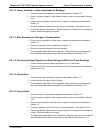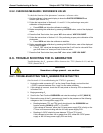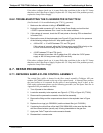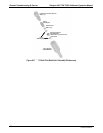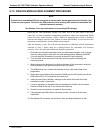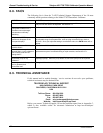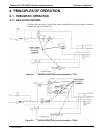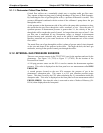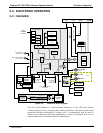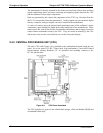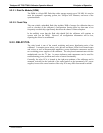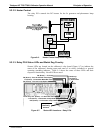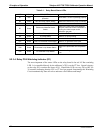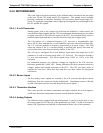
Principles of Operation Teledyne API T703/T703U Calibrator Operation Manual
192
9.1.1.1. Photometer Critical Flow Orifice
Critical flow orifices are a remarkably simple way to regulate stable gas flow rates.
They operate without moving parts by taking advantage of the laws of fluid dynamics.
By restricting the flow of gas though the orifice, a pressure differential is created. This
pressure differential combined with the action of the calibrator’s pump draws the gas
through the orifice.
As the pressure on the downstream side of the orifice (the pump side) continues to drop,
the speed that the gas flows though the orifice continues to rise. Once the ratio of
upstream pressure to downstream pressure is greater than 2:1, the velocity of the gas
through the orifice reaches the speed of sound. As long as that ratio stays at least 2:1 the
gas flow rate is unaffected by any fluctuations, surges, or changes in downstream
pressure because such variations only travel at the speed of sound themselves and are
therefore cancelled out by the sonic shockwave at the downstream exit of the critical
flow orifice.
The actual flow rate of gas through the orifice (volume of gas per unit of time), depends
on the size and shape of the aperture in the orifice. The larger the hole, the more gas
molecules, moving at the speed of sound, pass through the orifice.
9.1.2. INTERNAL GAS PRESSURE SENSORS
There are two pressure sensors in the T703/T703U: one for the regulator and one for the
photometer. See Figure 3-5 (T703) or Figure 3-7 (T703U) for the location of the
Pressure/Flow Sensor.
A 100 psig pressure
sensor on this PCA is used to monitor the downstream regulator
pressure. This value is displayed on the front panel as a test measurement called REG
PRESSURE.
A second pressure located on the rear PCA measures the pressure of gas in the
photometer’s absorption tube. This sensor is a 0-15 psia (absolute pressure) range
sensor. This data is used by the CPU when calculating the O
3
concentration inside the
absorption tube. This value is displayed on the front panel as a test measurement called
PHOTO SPRESS. Note that this value is converted to units of Inches of Mercury (IN-
HG-A) when displayed on the front panel.
07223C DCN6572




